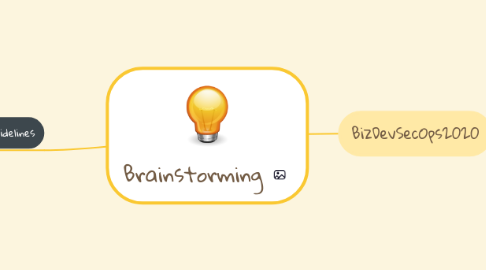
1. Guidelines
1.1. Anything goes!
1.2. No criticism or flaming allowed
1.3. The Wilder The Better
1.4. Quantity is Quality
1.5. Set a Time Limit
2. BizDevSecOps2020
2.1. Aceleradores
2.1.1. CLI/Scaffolding
2.1.1.1. Hub templates
2.1.1.2. SPA
2.1.1.3. node
2.1.1.4. java
2.1.1.5. Micro services templates
2.1.1.6. ruby
2.1.1.7. ios
2.1.1.8. android
2.1.1.9. hybrid
2.1.1.10. bigdata
2.1.1.11. python
2.1.2. Chatbot
2.1.2.1. integration with jira
2.1.2.2. open issue bug track
2.1.2.3. create infrastructure
2.1.2.4. open release management
2.1.2.5. notify deploy
2.1.2.6. Create repositories in GitLab
2.1.2.7. execute test
2.1.2.8. Commit code changes to GitLab
2.1.2.9. execute jenkins
2.1.2.10. promoted to rundeck
2.1.3. Self-Service Provisioning
2.1.3.1. Accelerate testing and programming efforts while reducing IT management and development costs.
2.2. IDE
2.2.1. Static Analysis
2.2.1.1. Metrics produced by static code analysis provide a means by which software quality can be measured and improved.
2.2.2. Unit test
2.2.2.1. unit test is code written by a developer that tests as small a piece of functionality (the unit) as possible
2.2.3. Sast
2.2.3.1. Static application security testing (SAST) is a set of technologies designed to analyze application source code
2.2.4. MF
2.2.4.1. Modern Eclipse-based IDE for Mainframe Development - Like Topaz
2.2.5. Service Virtualization
2.2.5.1. Simulates any integration between applications in the environment
2.2.6. Cross Browsing Testing
2.2.7. Mobile Debug
2.2.7.1. AWS Device Farm is an app testing service that lets you test and interact with your Android, iOS, and web apps on many devices at once, or reproduce issues on a device in real time. View video, screenshots, logs, and performance data to pinpoint and fix issues and increase quality before shipping your app.
2.3. CI/CD
2.3.1. Dynamic Pipeline steps
2.3.2. Custom Criteria
2.3.2.1. Application criticaness Analysis
2.3.2.2. Application Profile management
2.3.3. Feature Toggles
2.3.3.1. Feature Toggles (often also refered to as Feature Flags) are a powerful technique, allowing teams to modify system behavior without changing code.
2.3.4. Continuous Monitoring
2.3.4.1. SDLC Monitoring
2.3.4.2. Production Monitoring
2.3.4.3. Auto remediation
2.3.4.4. panic button
2.3.5. Gamification
2.3.5.1. Ranking Level
2.3.5.2. Deploy permissions by level
2.3.6. AI Insights
2.3.6.1. Artificial intelligence is the science of making machines do things requiring human intelligence. It is human intelligence in machine format where computer programs develop data-based decisions and perform tasks normally performed by humans.
2.3.7. Full traceability
2.3.7.1. Traceability is the capability to trace something. In some cases, it is interpreted as the ability to verify the history, location, or application of an item by means of documented recorded identification.
2.3.8. Green Light
2.3.8.1. Approval AI Engine for deploy Applications
2.3.8.2. Quality Criterias based on Application Profiles.
2.3.9. BizDevSecOps
2.3.9.1. Automation and Alignment of Incentives Across Business Units
2.3.10. SDLC in Cloud
2.3.10.1. Full software development ambient in web
2.3.11. Change Managment
2.3.11.1. Continuous Deployment
2.3.11.1.1. A/B Test
2.3.11.1.2. Canary Deployment
2.3.11.1.3. Blue Green
2.3.11.1.4. Gate Keeper
2.3.12. Chaos Engineering
2.3.12.1. Chaos Engineering is the discipline of experimenting on a distributed system in order to build confidence in the system’s capability to withstand turbulent conditions in production.
2.3.13. Single sign-on (SSO)
2.3.13.1. Single sign-on (SSO) is an authentication process that allows a user to access multiple applications with one set of login credentials. SSO is a common procedure in enterprises, where a client accesses multiple resources connected to a local area network (LAN).
2.3.14. Source Control Database
2.3.14.1. Version control for your database, delivering database changes across all your environments.
2.3.15. NoOps
2.3.15.1. NoOps (no operations) is the concept that an IT environment can become so automated and abstracted from the underlying infrastructure that there is no need for a dedicated team to manage software in-house.
2.3.16. bugtrack
2.3.16.1. A bug tracking system or defect tracking system is a software application that keeps track of reported software bugs in software development projects. It may be regarded as a type of issue tracking system.
2.4. New Techs
2.4.1. Blockchain
2.4.1.1. By allowing digital information to be distributed but not copied, blockchain technology created the backbone of a new type of internet
2.4.2. RPA
2.4.2.1. Robotic Process Automation, simple repetitive tasks that wont need human intervention should be automatized
2.4.3. .NET
2.4.4. BKS
2.4.4.1. jenkinsqa.isban.gs.corp
2.4.5. Batch MF
2.4.6. Online MF
2.4.7. WebSphere
2.4.7.1. IBM WebSphere Application Server. Create, connect and optimize applications for any environment, whether on premises or on a public, private or hybrid cloud.
2.4.8. WebLogic
2.4.8.1. Oracle WebLogic Server is the industry's best application server for building and deploying enterprise Java EE applications with support for new features
2.5. collaboration
2.5.1. pattern to colaborate
2.5.2. board global acceptance
2.5.3. global portal to share assets
2.5.4. DevOps periodic table
2.6. culture
2.6.1. meet-up
2.6.2. hackathon
2.6.3. Postmortem
2.6.3.1. Learning from Failure
2.6.4. devops days
2.6.5. devops workshop
2.6.6. blog tech
2.6.7. onboard bootcamp reception
2.6.7.1. notebook
2.6.7.2. starter kit santander
2.6.7.3. bootcamp
2.6.8. one-one with santander architecture
2.7. open-source
2.7.1. share with community
2.7.2. great relevance community
2.7.3. opensource project santander
2.7.4. OSS ( open-source software center)

